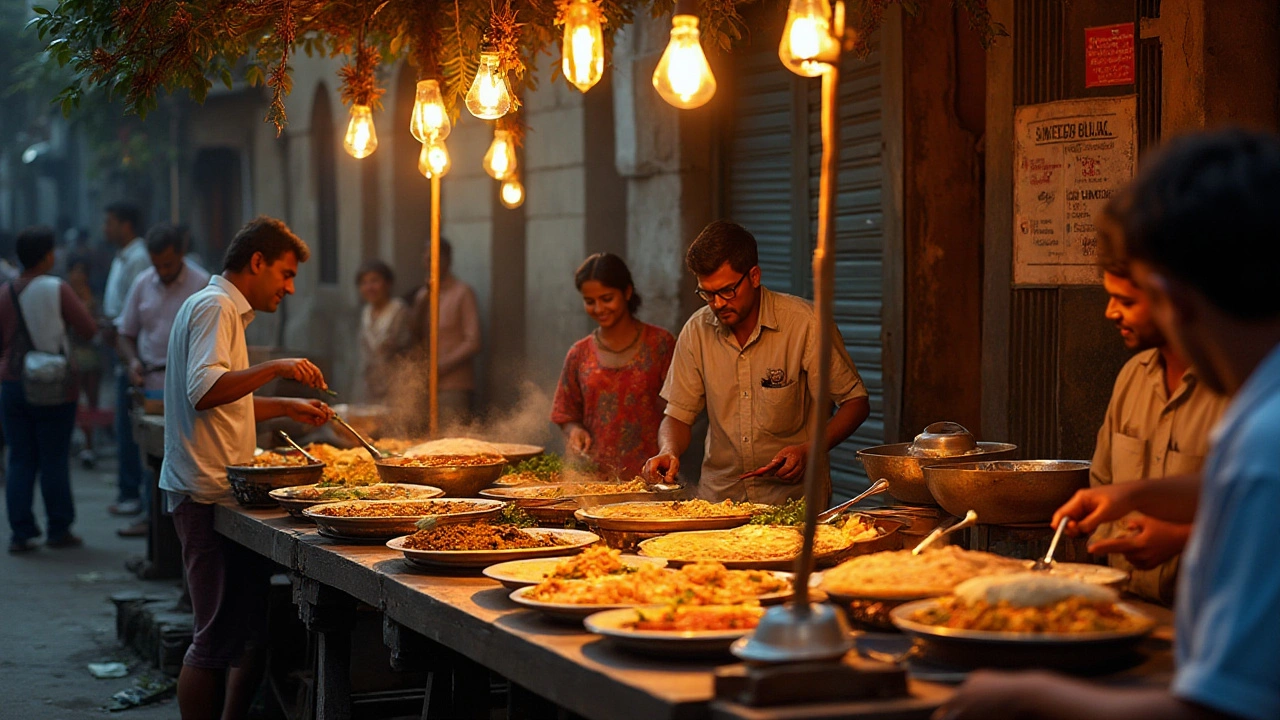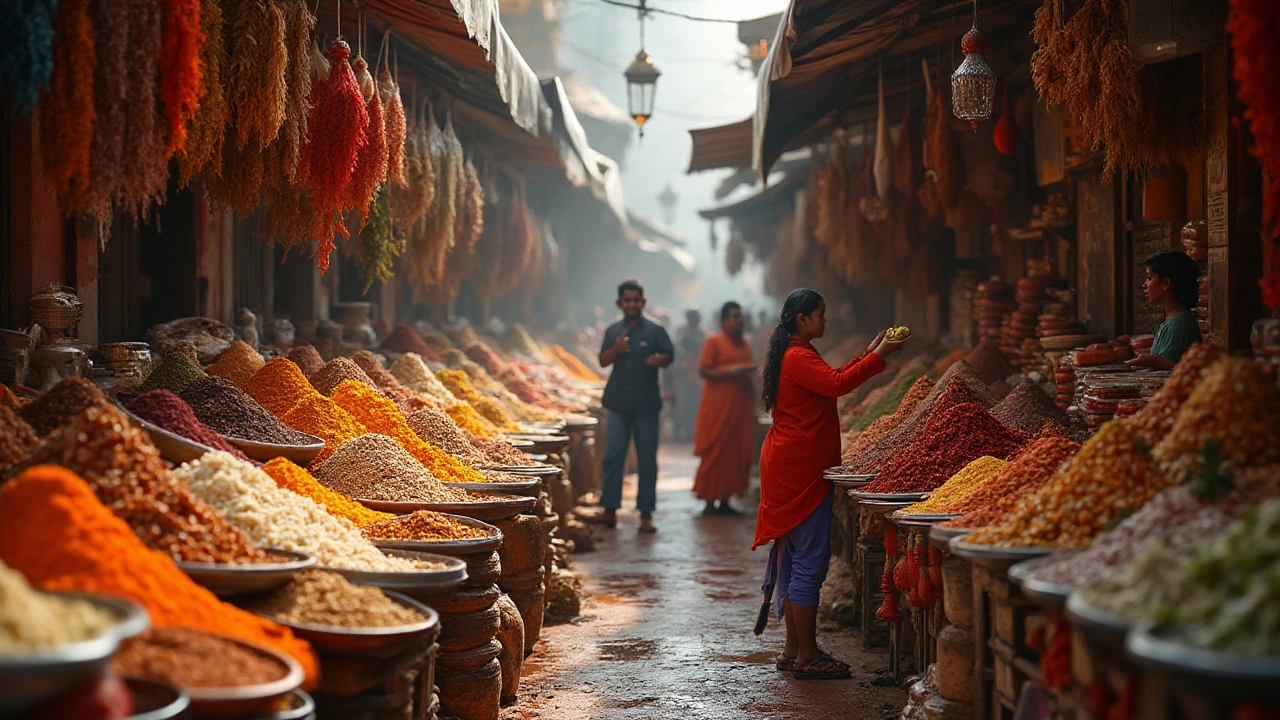When you step into the world of Indian cuisine, you're plunged into a universe of vibrant aromas, spices, and flavors. In a country where diversity is celebrated at every turn, food plays a significant role in daily life. As a traveler exploring India on a budget, experiencing the most commonly eaten foods not only gives you a taste of the local culture but also saves you some money.
Rice and roti tend to dominate the Indian food landscape, each bringing its unique flair to the table. Light, fluffy and often enriched with spices, rice frequents many a plate, while roti offers that comforting, chewy contrast. Let's not forget the role of lentils and legumes, which are budget-friendly sources of protein, forming the backbone of many meals.
The use of spices breathes life into dishes and sets the Indian dining experience apart. Venture into the world of street food, and you'll find affordable bites bursting with flavor, ideal for budget travelers. Whether paired with a sizzling curry or a simple daal, these staples will keep you satisfied and immersed in India’s culinary traditions.
- Rice and Roti: The Kings of Indian Meals
- Lentils and Legumes: Protein-Packed Goodness
- Spices and Flavors: The Heart of Indian Cuisine
- Street Food Delights: Affordable and Delicious
- Tips for Dining on a Budget in India
Rice and Roti: The Kings of Indian Meals
Rice and roti hold a cherished spot on the Indian table, each reflecting the geographical and cultural diversity across the country. As staples, they form the core of numerous regional cuisines and daily meals, their flexibility lending to a variety of flavorful accompaniments. In northern India, where the climate is conducive to wheat farming, roti becomes a daily bread. Not just a simple flatbread, roti is the heart of many households, eaten with curries, vegetables, and lentils. Meanwhile, in southern and eastern regions, rice reigns supreme. Its ability to absorb flavors makes it indispensable, from the spicy biryanis to the tangy tamarind rice, you’ll find it embraced in every meal.
One might wonder how two simple ingredients play such a vital role in the diet of over a billion people. It's all about accessibility and versatility. The cultivation of rice and wheat spans thousands of years, with techniques passed through generations. Each harvest season paints a picture of rural vibrancy as farmers gather these grains, knowing their importance in feeding the nation. The interplay of culture and agriculture ensures that no matter where you roam in India, a rice or roti dish is never far away, enhancing your budget travel in India by allowing you to savor authentic tastes at reasonable prices.
Roti's preparation method is intriguingly artful, demanding the perfectly balanced dough that, when placed onto an iron griddle, puffs up into a delightful pillow of taste. It's as much an experience as it is nourishment. Not to be outdone, rice brings its own stories to the table. It's said that India boasts over a hundred varieties of rice, each with its unique taste, texture, and aroma, filling homes with delightful scents as soon as the grains hit the boiling pot. An ancient wisdom recalibrates with every plateful, showing survival and adaption in unison.
As the day progresses from breakfast to dinner, rotis and rice transition seamlessly. A traveler can find themselves enjoying piping hot flatbreads in the morning accompanied by a simple chutney or spicy scrambled eggs, and by evening, partake in a rich rice pilaf seasoned with saffron and studded with vegetables. Both offer a nutrient-rich meal, providing essential carbohydrates that fuel the day’s activities, whether exploring bustling cities or serene landscapes.
While rice and roti each have their loyal fanbases, the beauty of Indian dining is in their coexistence, sometimes even in the same meal. Both staples are a testament to India’s culinary depth and ingenuity, ensuring travelers don’t just observe India’s culture, but taste it profoundly. As one Indian proverb goes, ‘Rice is never the main course, but without it, the meal is incomplete’. These words ring true, emphasizing the indispensable role these foods play in the Indian diet and the warmth they bring to those who share in the country’s rich culinary journey.
Lentils and Legumes: Protein-Packed Goodness
In the vast culinary landscape of India, lentils and legumes form a vital cornerstone, offering a hefty punch of protein and nutrition. These humble ingredients are more than just sustenance; they are deeply woven into the fabric of Indian meals, cherished across households for their adaptability and flavors. India, being one of the largest producers and consumers of lentils globally, treats dishes made from them not just as sides, but often as the centerpiece. These nutrient-rich powerhouses come in various forms, prominently featuring as

Spices and Flavors: The Heart of Indian Cuisine
When discussing the essence of Indian cuisine, the conversation invariably leads to its charismatic use of spices and flavors. The sheer variety and complexity of these elements in Indian cooking are unrivaled, transforming even the simplest ingredients into delectable feasts. From the smoky warmth of cumin to the vibrant yellow hue lent by turmeric, each spice tells a story of its own. These spices aren't just for flavor—a majority also boast numerous health benefits, deeply rooted in the ancient practices of Ayurveda. Turmeric, a stalwart in Indian kitchens, is revered not only for its flavor but also for its anti-inflammatory properties that bolster health. Indian cuisine has mastered the art of balancing spices delicately to create a symphony of taste that dances on the palate, making every meal a delightful experience.
Each region of India offers a distinct palette of spices that cannot be found elsewhere, highlighting the nation's vast diversity. In the northern parts, you'll often find the soothing aroma of garam masala, a unique blend of spices that may include cardamom, cloves, and black pepper. Meanwhile, the lush southern coastline often features the robust kick of mustard seeds and curry leaves in its dishes. As you travel from one state to another, it's evident that the spices used are deeply intertwined with the geographical, climatic, and cultural fabric of the region.
Culinary expert Madhur Jaffrey once remarked, "Indian food is like classical music raga - it takes time to build up, you can add a little here and something extra there."This sentiment resonates with the thoughtfulness required to layer flavors that are characteristic of Indian cuisine.
The art of blending spices is often passed down generations, with some combinations jealously guarded as family secrets. The spice market experience in India can be overwhelming yet exhilarating. One encounter with the vivid colors and potent aromas of a traditional bazaar, such as Delhi’s Khari Baoli, can provide an insight into the rich tapestry of Indian spices. These markets also reflect the country's age-old spice trade history, which once lured foreign merchants and explorers alike to India's shores. The spice trade considerably influenced global cuisine and, by extension, positioned India as a pivotal player in the culinary world. For those enamored with cooking, a trip to India offers the chance to explore these markets and discover how to incorporate spices into one's own culinary repertoire.
The magic of Indian cuisine lies not just in the spices themselves but in the unique methods of preparation, where toasting or grinding them fresh can completely alter the taste profile. A slight roasting of cumin seeds until they release a nutty aroma can add depth to a simple dish. Grinding spices as needed releases their volatile oils, filling the air with an aroma that stimulates all senses. Moreover, the technique of 'tempering'—briefly cooking spices in oil or ghee to unlock their flavors—is a fundamental practice across Indian households. This infusion of spices into the base of dals and curries is what often forms the backbone of any dish's flavor. Understanding these processes deepens one's appreciation of the craft involved in cooking Indian cuisine.
Street Food Delights: Affordable and Delicious
Exploring the streets of India is like stepping into a culinary carnival, where Indian cuisine bursts forth with colorful sights and enticing aromas. Street food is not merely food; it's an experience that connects you to India's rich culture and warm people. From the bustling streets of Delhi to the vivacious lanes of Mumbai, the diversity and creativity are staggering. Often priced at just a few rupees, each food stall offers a chance to sample the local fare without putting a dent in your wallet.
The rich tapestry of India is mirrored in its street food offerings. Pani Puri, a fan favorite, is a delightful treat consisting of hollow, crispy puris filled with spicy tamarind water, chickpeas, and potatoes. As you bite into it, you get a burst of tangy, spicy, and sweet flavors exploding in your mouth. Similarly, delving into a plate of Pav Bhaji, a spicy vegetable mash served with buttered bread, reveals the layers of spices that are quintessential in Indian cooking.
"Street food is the best reflection of India's culinary diversity," says chef and author Madhur Jaffrey. "It’s where you find innovation amidst tradition."
Another street food wonder, Bhel Puri, is a crunchy delight made with puffed rice, vegetables, and chutneys, and it remains a staple at beaches and parks. And let's not forget the spicy Kathi Rolls and the savory Chole Bhature, which draw crowds with their irresistibly bold flavors. En route, sip on Masala Chai or the cool sweetness of Aam Panna to refresh your palate.
Indian street food is not just about taste but about bringing people together. It's a communal experience where friends and strangers alike bond over shared love for street food. Additionally, experiencing these eats is a sustainable choice supporting local vendors, providing travelers with authentic encounters while contributing to the local economy. Should you visit, remember to approach each new dish with an open heart and an empty stomach, because street food in India promises to be an adventure you’ll cherish forever.

Tips for Dining on a Budget in India
Traveling through India presents a remarkable opportunity to savor its diverse cuisine without emptying your wallet. The country's culinary landscape is a feast for your senses, offering an abundance of flavors that adapt beautifully to budget-friendly adventures. If you're wise to the ways of dining economically, you'll discover authentic, delectable eats without compromising on taste. What's key here is immersion in the local food scene, where the real gems are found—a practice that is as enriching as it is economical.
A golden rule is to follow the locals. Frequent small, bustling restaurants or road-side dhabas, where the food is as lively as the people around. These establishments serve traditional fare like roti, chapati, and various rice dishes at a fraction of the cost you might expect. The hustle and chatter might be overwhelming at first, but embrace it; this is where India's culinary soul thrives. Street vendors also offer myriad options, from crispy samosas to spicy chaat, which are not only budget-friendly but also a crash course in India's street food delights.
"Eat where the chefs eat. Local joints have perfected a few dishes over decades—often the best meals are those with a line out the door," says food writer Rashmi Uday Singh.
Exploring local markets is another cost-effective strategy. These vibrant spaces brim with fresh fruits, spices, and cooked food items like dal and vegetable curries. For those who enjoy the DIY approach, purchasing ingredients to whip up simple meals can be both enjoyable and economical. Carry a small water bottle and refill it wherever you can find a safe source, reducing your dependence on buying bottled water throughout the day—a small but noteworthy saving.
A handy tool in your quest to dine economically in India is the thali—a platter that provides a little taste from varied dishes. This colorful assortment typically includes rice, lentils, vegetables, bread, and sometimes dessert. Often served as unlimited refills, thalis offer a way to sample diverse flavors, satiate hunger and stay within budget. Look for places with 'unlimited thali' deals, which allow you to indulge to your heart's content without the guilt of overspending.
Dining at off-peak hours can yield monetary benefits, too. Restaurants might offer meal deals or discounts outside of conventional timings, ensuring you get more bang for your buck. Be cautious with hygiene—a critical factor considered by seasoned travelers. Stick to bustling food spots with a high turnover, and pay attention to what is being cooked fresh. While you mind your spending, also cherish the joy of striking up conversations with locals who can guide you to hidden culinary treasures.
